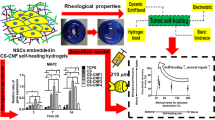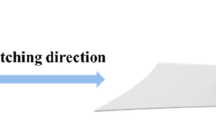Abstract
Ordered gelation under spin-coating conditions, as reported here, is a suitable method to order cells in biogels. Cell ordering is of great importance for functional repair of central nervous system (CNS) injuries, because therapies must include strategies to bridge chystic gaps and facilitate axon growth towards its target. Organized biocompatible and biodegradable substrates may be used for this purpose, to supply trophic support and provide directional cues for neuronal process outgrowth. Atomic force microscopy (AFM) and low temperature scanning electron microscopy (LTSEM), confirmed that fibrils in κ–carrageenan/chitosan and fibrin hydrogels prepared under spin-coating conditions, were longitudinally arranged. The cell model was conveniently tested using rat C6 glioma cells. C6 cells were distributed regularly in fibrin gels formed under centrifugal force. The ability of ordered fibrin scaffolds to promote uniform distribution of transplanted cells, was confirmed by fluorescence microscopy.
Similar content being viewed by others
References
NIETO-SAMPEDRO M, COLLAZOS-CASTRO JE, TAYLOR JS, GUDIÑO-CABRERA G, VERDÚ-NAVARRO E, PASCUAL-PIÉDROLA JI, INSAUSTI-SERRANO R. Traumatic injuries to the central nervous system and their repair. Rev Neurol 2002;35:534–52
Ramón y Cajal S. Estudios sobre la degeneración y regeneración del sistema nervioso. Imprenta de Hijos de Nicolás Moya, Madrid, 1914.
RICHARDSON PM, MCGUINNESS UM, AGUAYO AJ. Axons from CNS neurons regenerate into PNS grafts. Nature 1980;284:264–65.
NIETO-SAMPEDRO M. Neurite outgrowth inhibitors in gliotic tissue. Advances Exper Med Biol 1999;468:207–24.
GOLDBERG JL, KLASSEN MP, HUA Y, BARRES BA. Amacrine-signaled loss of intrinsic axon growth ability by retinal ganglion cells. Science 2002;296:1860–4.
WIDMER MS, MIKOS AG. Fabrication of biodegradable polymer scaffolds for tissue engineering. Chapter II.5 in Frontiers in tissue engineering. PATRICK JR CW, MIKOS AG, MCINTIRE LV, Eds. Elsevier Science Ltd, UK, 1998, p. 106–20.
SIPE JD, KELLEY CA, MCNICHOL LA, Eds. Reparative medicine: growing tissues and organs. Annals of the New York academy of sciences, New York, 2002, Vol. 961, p. 83–142.
GELLER HM, FAWCETT JW. Building a bridge: engineering spinal cord repair. Exp Neurol 2002;174:125–36.
PLANT GW, WOERLY S, HARVEY AR. Hydrogels containing peptide or aminosugar sequences implanted into the rat brain: influence on cellular migration and axonal growth. Exp Neurol 1997;143:287–99.
WOERLY S, PINET E, DE ROBERTIS L, VAN DIEP D, BOUSMINA M. Spinal cord repair with PHPMA hydrogel containing RGD peptides (NeuroGelTM). Biomaterials 2001;22:1095–111.
RANGAPPA N, ROMERO A, NELSON KD, EBERHART RC, SMITH GM. Laminin-coated poly(L-lactide) filaments induce robust neurite growth while providing directional orientation. J Biomed Mater Res 2000;51:625–34.
HALL H, BAECHI T, HUBBELL JA. Molecular properties of fibrin-based matrices for promotion of angiogenesis in vitro. Microvasc Res 2001;62:315–26.
DUBEY N, LETOURNEAU PC, TRANQUILLO RT. Neuronal contact guidance in magnetically aligned fibrin gels: effect of variation in gel mechano-structural properties. Biomaterials 2001;22:1065–75.
CEBALLOS D, NAVARRO X, DUBEY N, WENDELSCHAFER-CRABB G, KENNEDY WR, TRANQUILLO RT. Magnetically aligned collagen gel filling a collagen nerve guide improves peripheral nerve regeneration. Exp Neurol 1999;158:290–300.
DUBEY N, LETOURNEAU PC, TRANQUILLO RT. Guided neurite elongation and Schwann cell invasion into magnetically aligned collagen in simulated peripheral nerve regeneration. Exp Neurol 1999;158:338–50.
BESSEAU L, COULOMB B, LEBRETON-DECOSTER C, GIRAUD-GUILLE MM. Production of ordered collagen matrices for three-dimensional cell culture. Biomaterials 2002;23:27–36.
POLENTES J, STAMEGNA JC, NIETO-SAMPEDRO M, GAUTHIER P. Phrenic rehabilitation and diaphragm recovery after cervical injury and transplantation of olfactory ensheathing cells. Neurobiol Dis 2004;16:638–53.
LI Y, CARLSTEDT T, BERTHOLD CH, RAISMAN G. Interaction of transplanted olfactory-ensheathing cells and host astrocytic processes provides a bridge for axons to regenerate across the dorsal root entry zone. Exp Neurol 2004;188:300–8.
RIDDELL JS, ENRIQUEZ-DENTON M, TOFT A, FAIRLESS R, BARNETT SC. Olfactory ensheathing cell grafts have minimal influence on regeneration at the dorsal root entry zone following rhizotomy. Glia 2004;47:150–67.
NIETO-SAMPEDRO M. Central nervous system lesions that can and those that cannot be repaired with the help of olfactory bulb ensheathing cell transplants. Neurochem Res 2003;28:1659–76.
MUÑETÓN V, AVERILL S, KING V, YANG Q, DONCEL-PÉREZ E, CABALLERO S, WARD R, NIETO-SAMPEDRO M, PRIESTLEY J, TAYLOR J. Transplantation of olfactory ensheating cells fails to promote significant axonal regeneration from dorsal roots into the rat cervical cord. J Neurocytol 2003;32:53–70.
SAKIYAMA T, CHU CH, FUJII T, YANO T. Preparation of a polyelectrolyte complex gel from chitosan and kappa-carrageenan and its ph-sensitive swelling. J Appl Polym Sci 1993;50:2021–5.
SAKIYAMA T, TAKATA H, KIKUCHI M, NAKANISHI K. Polyelectrolyte complex gel with high pH-sensitivity prepared from dextran sulfate and chitosan. J Appl Polym Sci 1999;73:2227–33.
RYAN EA, MOCKROS LF, WEISEL JW, LORAND L. Structural origins of fibrin clot rheology. Biophys J 1999;77:2813–26.
RESNICK DK, CECHVALA CF, YAN Y, WITWER BP, SUN D, ZHANG S. Adult olfactory ensheathing cell transplantation for acute spinal cord injury. J Neurotrauma 2003;20:279–85.
VERDÚ E, GARCIA-ALIAS G, FORES J, LOPEZ-VALES R, NAVARRO X. Olfactory ensheathing cells transplanted in lesioned spinal cord prevent loss of spinal cord parenchyma and promote functional recovery. Glia 2003;42:275–86.
Author information
Authors and Affiliations
Corresponding author
Rights and permissions
About this article
Cite this article
Doncel-Pérez, E., Darder, M., Martín-López, E. et al. Gelation under dynamic conditions: A strategy for in vitro cell ordering. J Mater Sci: Mater Med 17, 795–802 (2006). https://doi.org/10.1007/s10856-006-9837-y
Received:
Accepted:
Issue Date:
DOI: https://doi.org/10.1007/s10856-006-9837-y




